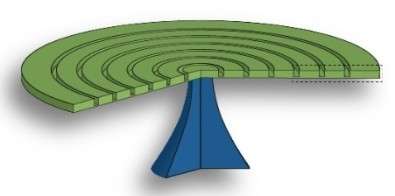Device boosts interaction between light and motion

Optomechanical devices, which simultaneously confine light waves and mechanical waves to permit interaction between them, can be used to study fundamental questions in physics and to sense motion similarly to electromechanical accelerometers. In smartphones, these electronic components switch the touchscreen between portrait and landscape when they detect rotation by the user.
According to experts in the field, however, the use of optomechanical devices to study macroscopic quantum phenomena or to identify very subtle movements requires extremely high levels of interaction, or coupling, between light waves and mechanical waves.
A group of researchers led by Thiago Pedro Mayer Alegre and Gustavo Silva Wiederhecker at the University of Campinas's Gleb Wataghin Physics Institute (IF-UNICAMP) in São Paulo State, Brazil, have developed an optomechanical device with a novel design that boosts the coupling between light waves and mechanical waves to higher levels than those reported for similar devices developed in the laboratory. Their work was supported by FAPESP.
The new optomechanical device and an experimental demonstration of its functioning are described in Optics Express.
"The way we designed the device allows the levels of interaction between light waves and mechanical waves to be increased," Alegre said.
"This means the device has practical applications and assists us in our basic research by helping us answer certain questions, such as what happens in the transition between the quantum microscopic world and the classical macroscopic world."
The device created by the researchers, based on a 24-micron silicon disk supported by a silicon dioxide central pedestal allowing the disk to vibrate, has a bullseye shape with concentric circular grooves. Thanks to this shape, light waves and mechanical waves can be confined within the device by separate mechanisms. The light waves are confined only at the edge of the disk by total internal reflection, an optical phenomenon whereby light within a medium such as water or glass is completely reflected from the surrounding surfaces (such as the air interface) back into the medium, provided the angle of incidence is greater than a certain limiting angle called the critical angle.
Light waves are therefore compressed near the disk edge and travel around the rings for a long time, whereas mechanical vibrations can propagate throughout the material. However, the concentric rings create frequency regions in which mechanical waves cannot propagate, and are confined to the outside edge of the disk, where they interact directly with the light waves.
"Confining light waves and mechanical waves to the disk edge enables us to boost their interaction, which is useful for exploring quantum phenomena in macroscopic objects," Alegre explained.
In devices developed by other research groups, the concentric circular grooves are used to confine light waves in the central region and not at the edge, as in the case of the device designed by the researchers at IF-UNICAMP.
Like optical vibrations, mechanical vibrations can be understood as waves, so Alegre's group had the idea of using the concentric rings to confine mechanical waves at the edge of the device and make them interact more intensely with light waves in the same region. "The point of developing the disk with this bullseye design was to prevent the mechanical mode from 'seeing' the central pedestal that supports the disk and allow the entire structure to vibrate, eliminating mechanical losses," he said.
The device is highly customizable, he added, and compatible with existing industrial fabrication processes, making it a solution for the enhancement of sensors that detect force and motion, for example. One of its potential applications is in telecommunications as an optical modulator, Alegre explained. Because the device can sense and excite mechanical vibration, it could be used as an optical switch, controlling a laser beam that passes through it far more efficiently than the modulating technologies used today in optical telecommunications networks.
"It was fabricated according to current industrial processes, so any group in the world could reproduce it," he said.
More information: "Hybrid confinement of optical and mechanical modes in a bullseye optomechanical resonator" Optics Express (2017). DOI: 10.1364/OE.25.00508
Journal information: Optics Express
Provided by FAPESP





















